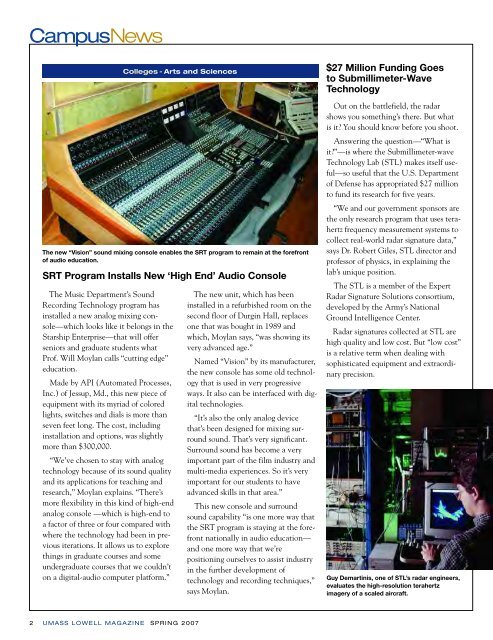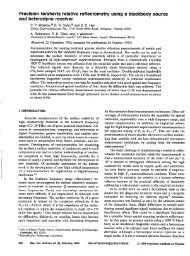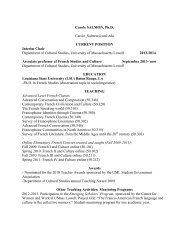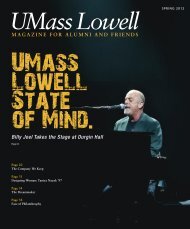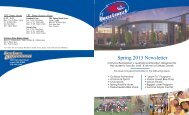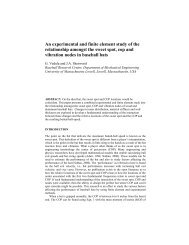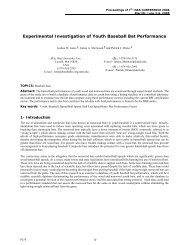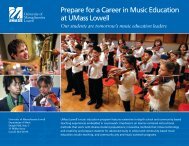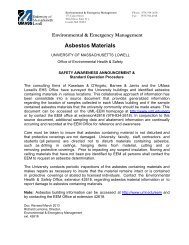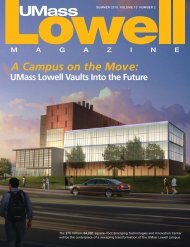Spring 2007 - University of Massachusetts Lowell
Spring 2007 - University of Massachusetts Lowell
Spring 2007 - University of Massachusetts Lowell
You also want an ePaper? Increase the reach of your titles
YUMPU automatically turns print PDFs into web optimized ePapers that Google loves.
CampusNews<br />
The new “Vision” sound mixing console enables the SRT program to remain at the forefront<br />
<strong>of</strong> audio education.<br />
SRT Program Installs New ‘High End’ Audio Console<br />
The Music Department’s Sound<br />
Recording Technology program has<br />
installed a new analog mixing console—which<br />
looks like it belongs in the<br />
Starship Enterprise—that will <strong>of</strong>fer<br />
seniors and graduate students what<br />
Pr<strong>of</strong>. Will Moylan calls “cutting edge”<br />
education.<br />
Made by API (Automated Processes,<br />
Inc.) <strong>of</strong> Jessup, Md., this new piece <strong>of</strong><br />
equipment with its myriad <strong>of</strong> colored<br />
lights, switches and dials is more than<br />
seven feet long. The cost, including<br />
installation and options, was slightly<br />
more than $300,000.<br />
“We’ve chosen to stay with analog<br />
technology because <strong>of</strong> its sound quality<br />
and its applications for teaching and<br />
research,” Moylan explains. “There’s<br />
more flexibility in this kind <strong>of</strong> high-end<br />
analog console —which is high-end to<br />
a factor <strong>of</strong> three or four compared with<br />
where the technology had been in previous<br />
iterations. It allows us to explore<br />
things in graduate courses and some<br />
undergraduate courses that we couldn’t<br />
on a digital-audio computer platform.”<br />
Colleges - Arts and Sciences<br />
The new unit, which has been<br />
installed in a refurbished room on the<br />
second floor <strong>of</strong> Durgin Hall, replaces<br />
one that was bought in 1989 and<br />
which, Moylan says, “was showing its<br />
very advanced age.”<br />
Named “Vision” by its manufacturer,<br />
the new console has some old technology<br />
that is used in very progressive<br />
ways. It also can be interfaced with digital<br />
technologies.<br />
“It’s also the only analog device<br />
that’s been designed for mixing surround<br />
sound. That’s very significant.<br />
Surround sound has become a very<br />
important part <strong>of</strong> the film industry and<br />
multi-media experiences. So it’s very<br />
important for our students to have<br />
advanced skills in that area.”<br />
This new console and surround<br />
sound capability “is one more way that<br />
the SRT program is staying at the forefront<br />
nationally in audio education—<br />
and one more way that we’re<br />
positioning ourselves to assist industry<br />
in the further development <strong>of</strong><br />
technology and recording techniques,”<br />
says Moylan.<br />
$27 Million Funding Goes<br />
to Submillimeter-Wave<br />
Technology<br />
Out on the battlefield, the radar<br />
shows you something’s there. But what<br />
is it? You should know before you shoot.<br />
Answering the question—“What is<br />
it?”—is where the Submillimeter-wave<br />
Technology Lab (STL) makes itself useful—so<br />
useful that the U.S. Department<br />
<strong>of</strong> Defense has appropriated $27 million<br />
to fund its research for five years.<br />
“We and our government sponsors are<br />
the only research program that uses terahertz<br />
frequency measurement systems to<br />
collect real-world radar signature data,”<br />
says Dr. Robert Giles, STL director and<br />
pr<strong>of</strong>essor <strong>of</strong> physics, in explaining the<br />
lab’s unique position.<br />
The STL is a member <strong>of</strong> the Expert<br />
Radar Signature Solutions consortium,<br />
developed by the Army’s National<br />
Ground Intelligence Center.<br />
Radar signatures collected at STL are<br />
high quality and low cost. But “low cost”<br />
is a relative term when dealing with<br />
sophisticated equipment and extraordinary<br />
precision.<br />
Guy Demartinis, one <strong>of</strong> STL’s radar engineers,<br />
evaluates the high-resolution terahertz<br />
imagery <strong>of</strong> a scaled aircraft.<br />
2 UMASS LOWELL MAGAZINE SPRING <strong>2007</strong>


